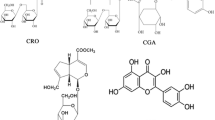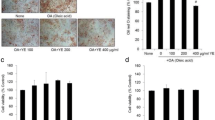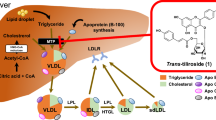Abstract
Hyperlipidemia is a well-known risk factor for atherosclerosis and statins are widely used to treat patients with elevated levels of lipids in their plasma. Notwithstanding the proven benefits of statin drugs on both primary and secondary prevention of heart disease, the high cost of statin treatment, in addition to possible side effects such as liver function abnormalities, may limit their widespread use. We conducted a study on a natural product as an alternative to statin treatment. Cholestin, a dietary supplement, is prepared from rice fermented with red yeast (Monascus purpureus), which has been shown to significantly decrease total cholesterol levels in hyperlipidemic subjects. Our objective was to determine the cellular effect of Cholestin on cholesterol synthesis in human hepatic cells (HepG2) and the mechanism by which it caused a change in lipid metabolism. Cholestin had a direct inhibitory effect on HMG-CoA reductase activity (78–69% of control). Cholesterol levels in HepG2 cells treated with Cholestin (25–100 μg/mL) were significantly reduced in a dose-dependent manner (81–45% of control, respectively). This reduction was associated with decreased synthesis and secretion of both unesterified cholesterol (54–31 and 33–14% of control, respectively) and cholesteryl ester (18–6 and 37–19% of control, respectively). These results indicate that one of the anti-hyperlipidemic actions of Cholestin is a consequence of an inhibitory effect on cholesterol biosynthesis in hepatic cells and provide the first documentation of a biomolecular action of red yeast rice.
Similar content being viewed by others

References
Randomized trial of cholesterol lowering in 4444 patients with coronary heart disease: The Scandinavian Simvastatin Survival Study (4S). Lancet 344: 1383–1389, 1994
Shepherd J, Cobbe SM, Ford I, Isles CG, Lorimer AR, MacFarlane PW, McKillop JH, Packard CJ: Prevention of coronary heart disease with pravastatin in men with hypercholesterolemia. West of Scotland Coronary Prevention Study Group. N Engl J Med 333: 1301–1307, 1995
Sacks FM, Pfeffer MA, Moye LA, Rouleau JL, Rutherford JD, Cole TG, Brown L, Warnica JW, Arnold JM, Wun CC, Davis BR, Braunwald E: The effect of pravastatin on coronary events after myocardial infarction in patients with average cholesterol levels. N Engl J Med 335: 1001–1009, 1996
Alberts AW: Lovastatin and simvastatin - inhibitors of HMG CoA reductase and cholesterol biosynthesis. Cardiology 77(suppl 4): 14–21, 1990
Beisiegel U: Lipoprotein metabolism. Eur Heart J 19(suppl A): A20–A23, 1998
Fielding CJ, Fielding PE: Intracellular cholesterol transport. J Lipid Res 38: 1503–1521, 1997
Lehmann EL: Nonparametrics: Statistical Methods Based on Ranks. Holden-Day, San Francisco, 1975
Perreault S, Hamilton VH, Lavoie F, Grover S: Treating hyperlipidemia for the primary prevention of coronary disease. Are higher dosages of lovastatin cost-effective? Arch Int Med 158: 375–381, 1998
Heber D, Yip I, Ashley JM, Elashoff DA, Elashoff RM, Go VLW: Cholesterol-lowering effects of a proprietary Chinese red-yeast-rice dietary supplement. Am J Clin Nutr 69: 231–236, 1999
Stuart MD: Chinese material medica-vegetable kingdom. Southern Materials Centre, Inc., Taipei, 1979
O K, Lynn EG, Chung YH, Siow YL, Man RYK, Choy PC: Homocysteine stimulates the production and secretion of cholesterol in hepatic cells. Biochim Biophys Acta 1393: 317–324, 1998
Wilce PA, Kroon PA: Assay of 3-hydroxy-3-methylglutaryl coenzyme A (HMG-CoA) reductase: In: C.A. Converse, E.R. Skinner (eds). Lipoprotein Analysis. A Practical Approach. IRL Press, Oxford, 1992, pp 303–314
O K, Choy PC: Effects of fasting on phosphatidylcholine biosynthesis in hamster liver: Regulation of choline phosphotransferase activity by endogenous argininosuccinate. Biochem J 289: 727–733, 1993
Expert Panel of Detection, Evaluation, and Treatment of High Blood Cholesterol in Adults. National Cholesterol Education Program. Second report of the Expert Panel of Detection, Evaluation, and Treatment of High Blood Cholesterol in Adults (Adult Treatment Panel II). I. Classification, prevalence, detection, and evaluation. Circulation 89: 1344–1363, 1432-1445, 1994
Ross R: The pathogenesis of atherosclerosis: A perspective for the 1990s. Nature 362: 801–809, 1993
Faruqui RM, DiCorleto PE: Mechanisms of monocyte recruitment and accumulation. Br Heart J 69(suppl): S19–S29, 1993
Raines EW, Ross R: Smooth muscle cells and the pathogenesis of the lesions of atherosclerosis. Br Heart J 69(suppl): S30–S37, 1993
Berlin JA, Navab M, Fogelman AM, Frank JS, Demer LL, Edwards PA, Watson AD, Lusis AJ: Atherosclerosis: Basic mechanisms, oxidation, inflammation, and genetics. Circulation 91: 2488–2496, 1995
Bradford RH, Shear CL, Chremos AN, Dujovne CA, Franklin FA, Grillo RB, Higgins J, Langendorfer A, Nash DT, Pool JL: Expanded Clinical Evaluation of Lovastatin (EXCEL) study results: Two-year efficacy and safety follow-up. Am J Cardiol 74: 667–673, 1994
Greenspan P, Yu H, Mao F, Gutman RL: Cholesterol deposition in macrophages: Foam cell formation mediated by cholesterol-enriched oxidized low density lipoprotein. J Lipid Res 38: 101–109, 1997
Havel RJ: Dietary supplement or drug? The case of Cholestin. Am J Clin Nutr 69: 175–176, 1999
Havel RJ, Hunninghake DB, Illingworth DR, Lees RS, Stein EA, Tobert JA, Bacon SR, Bolognese JA, Frost PH, Lamkin GE: Lovastatin (Mevinolin) in the treatment of heterozygous familial hypercholesterolemia: A multicenter study. Ann Int Med 107: 609–615, 1987
Miettinen TA, Gylling H: Regulation of cholesterol metabolism by dietary plant sterols. Curr Opin Lipid 10: 9–14, 1999
Jones PJ, Ntanios F: Comparable efficacy of hydrogenated vs. nonhydrogenated plant sterol esters on circulating cholesterol levels in humans. Nutr Rev 56: 245–248, 1998
Parker RA, Pearce BC, Clark RW, Gordon DA, Wright JJ: Tocotrienols regulate cholesterol production in mammalian cells by post-transcriptional suppression of 3-hydroxy-3-methylglutaryl-coenzyme A reductase. J Biol Chem 268: 11230–11238, 1993
Lloyd DB, Thompson JF: Transcriptional modulators affect in vivo protein binding to the low density lipoprotein receptor and 3-hydroxy-3-methylglutaryl coenzyme A reductase promoters. J Biol Chem 270: 25812–25818, 1995
Funatsu T, Suzuki K, Goto M, Arai Y, Kakuta H, Tanaka H, Yasuda S, Ida M, Nishijima S, Miyata K: Prolonged inhibition of cholesterol synthesis by atorvastatin inhibits apo B-100 and triglyceride secretion from HepG2 cells. Atherosclerosis 157: 107–115, 2001
Scharnagl H, Schinker R, Gierens H, Nauck M, Wieland H, Marz W: Effect of atorvastatin, simvastatin, and lovastatin on the metabolism of cholesterol and triacylglycerides in HepG2 cells. Biochem Pharmacol 62: 1545–1555, 2001
Rights and permissions
About this article
Cite this article
Man, R.Y., Lynn, E.G., Cheung, F. et al. Cholestin inhibits cholesterol synthesis and secretion in hepatic cells (HepG2). Mol Cell Biochem 233, 153–158 (2002). https://doi.org/10.1023/A:1017487815091
Issue Date:
DOI: https://doi.org/10.1023/A:1017487815091



